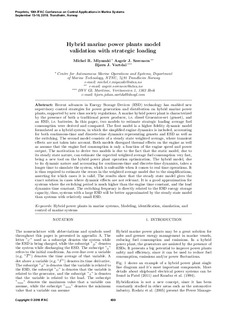| dc.description.abstract | Recent advances in Energy Storage Devices (ESD) technology has enabled new supervisory control strategies for power generation and distribution on hybrid marine power plants, supported by new class society regulations. A marine hybrid power plant is characterized by the presence of both a traditional power producer, i.e. diesel Generator-set (genset), and an ESD, i.e. batteries. In this paper, two models to estimate strategic loading average fuel consumption were derived and compared. The first model is a higher fidelity dynamic model formulated as a hybrid system, in which the simplified engine dynamics is included, accounting for both continuous-time and discrete-time dynamics representing gensets and ESD as well as the switching. The second model consists of a steady state weighted average, where transient effects are not taken into account. Both models disregard thermal effects on the engine as well as assume that the engine fuel consumption is only a function of the engine speed and power output. The motivation to derive two models is due to the fact that the static model, due to its steady state nature, can estimate the expected weighted average fuel consumption very fast, being a new tool on the hybrid power plant operation optimization. The hybrid model, due to its dynamic nature and accounting for continuous-time and discrete-time dynamics, takes a longer time to simulate the system, which is unfeasible when it comes to real time operations. It is thus required to estimate the errors in the weighted average model due to the simplifications, asserting for which cases it is valid. The results show that the steady state model gives the exact solution in cases where dynamic effects are not relevant. It is a good approximation for systems where the switching period is much higher than the engine time constant, and the load dynamics time constant. The switching frequency is directly related to the ESD energy storage capacity, thus, systems with a large ESD will be better approximated by the steady state model than systems with relatively small ESD. | nb_NO |
